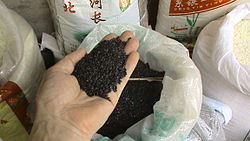Black rice

Black rice (also known as purple rice or forbidden rice) is a range of rice types of the species Oryza sativa L., some of which are glutinous rice. Varieties include Indonesian black rice and Thai jasmine black rice. Black rice is high in nutritional value and is a source of iron, vitamin E, and antioxidants (more than in blueberries).[1] The bran hull (outermost layer) of black rice contains one of the highest levels of anthocyanin antioxidants found in food.[2] The grain has a similar amount of fiber to brown rice and, like brown rice, has a mild, nutty taste.[3][4]
Black rice has a deep black color and usually turns deep purple when cooked. Its dark purple color is primarily due to its anthocyanin content, which is higher by weight than that of other colored grains.[5][6] It is suitable for making porridge, dessert, traditional Chinese black rice cake, bread, and noodles.
Nutritional value

Black rice contains essential amino acids like lysine and tryptophan; vitamins such as thiamine (B1), riboflavin (B2), and folic acid (B9); and dietary minerals including iron, zinc, calcium, manganese, and phosphorus.[citation needed]
References
- ^ [1] Whole Grain Council "BLACK RICE RIVALS BLUEBERRIES AS ANTIOXIDANT SOURCE", Zhimin Xu at the Louisiana State University Agricultural Center Study, August 26, 2010, (note: presentation at the National Meeting of the American Chemical Society, Boston MA)
- ^ Yao, S. L.; Xu, Y; Zhang, Y. Y.; Lu, Y. H. (2013). "Black rice and anthocyanins induce inhibition of cholesterol absorption in vitro". Food & Function. 4 (11): 1602–8. doi:10.1039/c3fo60196j. PMID 24056583.
- ^ "Food Grains of India". 232-234. 1892: 234. JSTOR 4102547.
{{cite journal}}: Cite journal requires|journal=(help) - ^ Lynch, William (14 September 2011). "Nutrition Differences in Black Rice Vs. Brown Rice". LIVESTRONG. Lance Armstrong Foundation. Retrieved 24 April 2012.
- ^ Takashi Ichiyanagi, Bing Xu, Yoichi Yoshii, Masaharu Nakajima, Tetsuya Konishi, "Antioxidant Activity of Anthocyanin Extract from Purple Black Rice." Journal of Medicinal Food. December 1, 2001, 4(4): 211-218.
- ^ Abdel-aal El-Sayed M.; Young J. Christopher; Rabalski Iwona. "Anthocyanin composition in black, blue, pink, purple, and red cereal grains." Journal of agricultural and food chemistry. 2006, vol. 54: 13, p. 4696-4704.
Oikawa, T.; Maeda, H.; Oguchi, T.; Yamaguchi, T.; Tanabe, N.; Ebana, K. Yano; M., Ebitani; T., Izawa, T. (2015). "The birth of a black rice gene and its local spread by introgression". Plant Cell. doi:10.1105/tpc.115.00310.{{cite journal}}: CS1 maint: multiple names: authors list (link)

